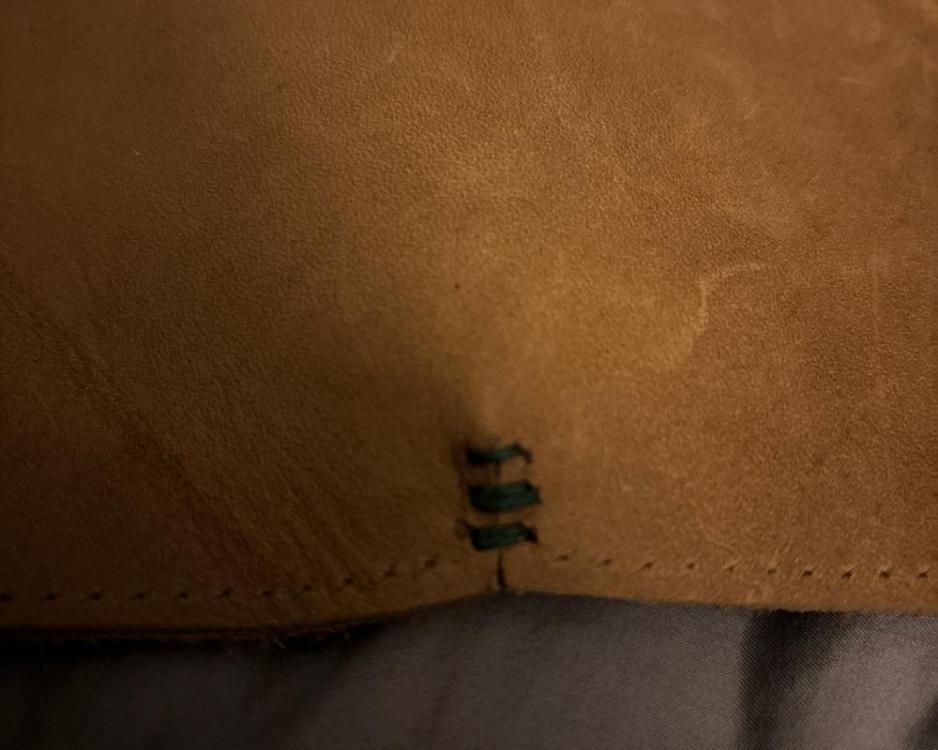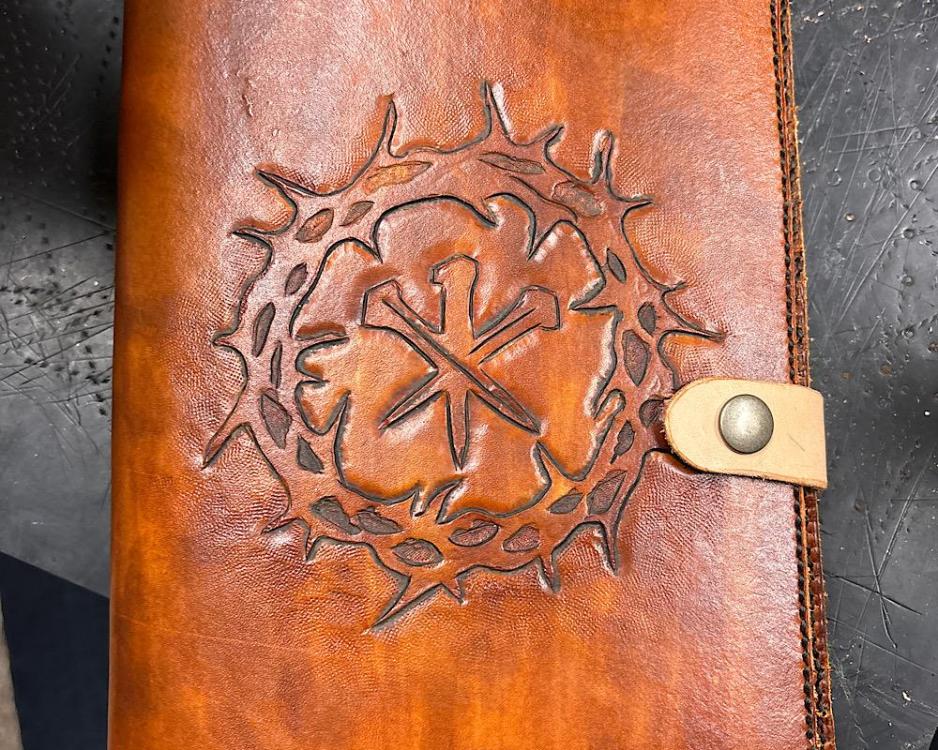
Mablung
Members-
Posts
569 -
Joined
-
Last visited
Content Type
Profiles
Forums
Events
Blogs
Gallery
Everything posted by Mablung
-
6 inch hollow ground Splitter blades need sharpening
Mablung replied to Doc Reaper's topic in Sharpen it!
Sounds like a 1000-grit waterstone, or the equivalent in another kind of abrasive, would be a good place to start. 220-grit waterproof sandpaper might work, too, then work up through 320 and 400, followed by a good stropping.- 11 replies
-
- splitter blades
- 6 inch splitter
- (and 3 more)
-
I’ll post some pictures some time soon, although “soon” might mean the end of the week. Hopefully earlier than that.
-
Thanks for the suggestions. I modified this heel pattern to curve a little bit more, at least at the top. I’m a believer in changing this incrementally, so I’ll probably go ahead and try just with the dart, then make another pair. I could use some low-top shoes as well, so I might as well continue to fiddle. Plus, I have a whole side of SB Foote to work with, so I can make a large number of brown shoes. Good thought on the Kamsnap setter. I’ll take a look. The weird thing is, my 1/4” eyelets set just fine, no problems. I’m going to look at the anvil again and at Tandy to see if part of my setup is defective—I can feel a little burr around the outside of the setting eye in the middle, so I may just need to polish it with a small, fine file.
-
Look at the tutorials on sharpening head knives in the Leather Tools and Sharpen It! subforums’ sticky threads. The chap who owns Leather Wranglers (can’t think of his name) does a video on which he demonstrates sharpening one of his knives. Probably the best video I’ve seen. Used his advice to get my vintage CS Osborne knife into scary sharp skiving shape. Learn to cut and skive with that single head knife, and you’ll be just fine. Not much you can’t do with a good head or round knife.
-
Didn’t get everything done, but I at least got the dart right and did the butt joint to make the seam at the back. If I can ever get the 3/16” eyelets to set properly, I’ll be in business. For some reason, they keep coming out crooked and partially smashed. I think my setting anvil may be the wrong size, although the setter itself looks right.
-
Hoping to get them done today and posted. How to do the dart @Aven described finally clicked in my head, so I tried it last night. I WAY overdid the dart, so I need to redo one upper, but I know now I got the idea basically right. I just need to tinker with the height and width of the dart to get it right. The leather I’m using is 5.5 oz., so I need to make it less dramatic than I thought I would.
-
I had no idea such a thing existed until I went into the store a few months ago, saw the alum tan, and thought, “What the heck is that?”
- 8 replies
-
- painting on leather
- help
- (and 9 more)
-
To that point, my local Tandy has some straight white alum tan for sale. I’ve seen chrome tan that’s already struck white.
- 8 replies
-
- painting on leather
- help
- (and 9 more)
-
what type of glue to finish linen thread saddle stitch?
Mablung replied to thekid77's topic in Sewing Leather
I burn the end of poly thread to keep it from unraveling. That and that helps shrink it back if I can’t trim it close to the surface for some reason. It’s not to keep the stitching from working loose; it still can, even if the end of the thread is melted. Feel free to put glue, if you like. Just about any glue would likely work. The only point anyone pointing out you don’t have to do that, is that you don’t have to do that if you have matched the thread size and hole size. -
That’s good advice. I need to do a few holsters soon, so I’ll make liberal use of that advice. Yeah, didn’t realize just how soft it is until I was wrangling it to line a glasses case this evening. Not terrible to work with, but it was more difficult than I thought it would be. I’ll post a few pics of that case soon, if for no other reason to get everyone to share some collective disgust with my pattern and how messy the edges are going to be. It’ll be the world’s ugliest but bombproof glasses case.
-
What kind of leather is this?
Mablung replied to panchoskywalker's topic in Leatherwork Conversation
Could be a lot of things. Can’t really tell just from those two pictures. -
Question on dyeing.
Mablung replied to Tophee's topic in Dyes, Antiques, Stains, Glues, Waxes, Finishes and Conditioners.
Resolene should work as a resist. Test it on a scrap piece to be sure. With any resist, it’s important to not leave the antique paste on too long. Most of those coatings aren’t absolutely “antique proof,” if you will, so it is important to wipe the antique off quickly if you only want it to stay in the stamp grooves. Otherwise, it dries in place and becomes more difficult to remove. -
what type of glue to finish linen thread saddle stitch?
Mablung replied to thekid77's topic in Sewing Leather
I’ve got a holster with thread and stitch holes that are grossly mismatched, and even then the thread hasn’t worked loose. Linen specifically might be a little more likely to, but properly matched thread and stitching hole sizes seem to eliminate that issue. -
Question on dyeing.
Mablung replied to Tophee's topic in Dyes, Antiques, Stains, Glues, Waxes, Finishes and Conditioners.
Happy to contribute what little I can. If I’m honest, I’ll tell you that the posts on this site are where I have learned most of what I know. There is sooo much to learn, and that’s part of the fun. You have the right attitude about it. You can also thin the dye to make it a lighter brown. This notebook cover was done with a Fiebing’s Light Brown dye, but I thinned it with denatured alcohol, about 50/50 (editing to say: might have thinned it more like 40% dye, 60% alcohol). I’ve done a couple knife sheaths with the same dye without thinning it—those turned out about the same color as the piece you showed. Yet another knife sheath was done closer to 50/50 or maybe 60/40 and got it darker than the notebook cover but lighter than the other sheaths. Thinning it made all the difference. Just another aspect to experiment with. -
Question on dyeing.
Mablung replied to Tophee's topic in Dyes, Antiques, Stains, Glues, Waxes, Finishes and Conditioners.
If you want the stamp impressions to be more obviously visible due to contrast, a lighter dye will certainly help. Darker dyes are more forgiving of the application of multiple layers to cover streaks, blots, and other mistakes, but a great part of that depends on your application method, too. Leatherwork offers innumerable rabbit holes, of which this is only one. Welcome to the hobby! -
Question on dyeing.
Mablung replied to Tophee's topic in Dyes, Antiques, Stains, Glues, Waxes, Finishes and Conditioners.
Antiquing is done after dyeing. There are a bunch of really helpful threads on here about everything dyeing and antiquing. Some people will do an overall background dye, then dye just the stamped/tooled area with another dye. Others use antique paste or even Sharpie markers. It depends on the look you want. Antique paste can be a bit messy and involves some extra steps, but it does give a nice look to certain things. Have fun learning and experimenting with all this. Look up The Leather Element videos Weaver Leathercraft puts on YouTube. The guy who presents them, Chuck Dorsett, has a couple on antiquing that I’ve found very helpful. -
Title says most of the question. I’ve got a sheepskin and a cow single shoulder, both veg tan and both around 3 oz., I plan to use as lining. Sheepskin was purchased originally to line a glasses case. Then I got the single shoulder because it was a good price and useful for lots of things. Then I wondered which would be better for lining a holster I plan to make soon. All of my pistols have forward slide serrations, so I’m concerned about longevity of the lining. Veg tan the lining will be regardless, because I don’t want to use suede (due to the effects of chrome tannage and of grit getting caught up in the fibers—both are bad for a pistol’s finish). Thoughts?
-
Question on dyeing.
Mablung replied to Tophee's topic in Dyes, Antiques, Stains, Glues, Waxes, Finishes and Conditioners.
Do you mean there’s not much contrast that highlights the stamp? -
Hm. I get that. Screwed up the first foam pattern I made, so I made it about 15% bigger (just what that one happened to require) and went from there. You can probably fix this one by just adding some extra to the edge, cutting a new foam pattern, and tweaking the other proportions until you get it right. If you haven’t yet, also look at JLSLeather’s guide to laying out patterns. Immensely helpful.
-
Are you able to identify to any extent where your pattern breaks down? It’s obvious something isn’t translating properly, but likely it’s one or two things that you’re not applying or thinking through properly that are then having flow-down effects on the end product. Any idea where things start to turn left of straight, so to speak?
-
I think there is some that’s 3 or 3.5 mm as well. That’s what I got, as that’s quite close to 6/7 oz. leather.
-
Hope it works for you. It’s a few bucks well-spent and easy to work with.
-
Something I have found immensely helpful is making a mockup out of EVA craft foam. The “medium” thickness is right about the same as 6 oz leather, so it works very nicely for mockups to check fit, before cutting into the leather. I’ve used it to then modify my paper patterns and then used the final mockup as my tracing and cutting pattern, when I move to cutting the leather.



